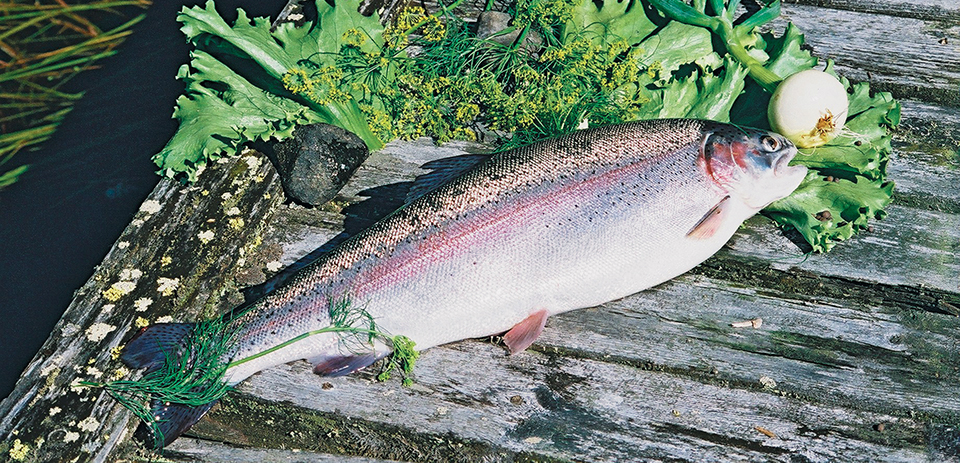Studies in Finland find four key quality traits displayed significant genetic variation

A highly valued feature of salmonid fish is their reddish meat color, which results from carotenoid pigments in their feed. Carotenoids are one of the most expensive fish feed ingredients. Fish-farming production efficiency and profitability can be increased by improving the ability of fish to incorporate carotenoids from feed into their flesh.
Body composition and meat quality are further essential characteristics of farmed fish, because they influence consumer acceptance and affect processing. The production of high-quality fish also involves improving production efficiency, because aquafarmers want to produce as much high-quality edible meat as possible for a given amount of aquafeed used.
Improving quality
Among farm animal producers, much attention has been paid to body and meat composition, mainly due to the reduction in meat quality that results during breeding programs, but also increased awareness by meat processors and consumers. These same issues can be addressed to improve quality in fish farming, but information is limited on the genetic properties of quality traits for aquaculture species.
Key traits
To examine the potential for the genetic improvement of rainbow trout (Oncorhynchus mykiss), the authors recently carried out a quantitative genetic study within a large-scale breeding program maintained by the Finnish Game and Fisheries Research Institute (FGFRI) and MTT Agrifood Research Finland.
The analysis of 3-year-old, 3-kg fish revealed that four key quality traits – fillet redness, fat content, amount of visceral fat, and percentage of body weight – displayed significant genetic variation. This allows their effective genetic improvement along with the highly heritable, main production traits of growth rate and timing of maturity.
These results were encouraging for practical applications. Using selective breeding, rainbow trout flesh can be made redder and its fat content reduced. Selection for the amount of visceral fat and percent fillet weight can, in turn, be applied to increase the amount of fillet produced per fish. These practices increase fish quality and make fish production more cost effective.
Because fat is a fundamental component in physiological processes such as reproduction, fish need operative intestines to effectively convert feed to fish biomass. Care should be taken to monitor the impact of quality selection on reproduction, survival, and feed efficiency.
Analysis also showed that mature fish displayed reduced meat quality. To control for the maturity-induced quality reduction, the timing of maturity was included in the selection index of the FGFRI /MTT breeding program.
Growth rate and quality traits
Genetic correlations between growth rate and quality traits can predict the degree to which the qualities change when selection is applied to growth rate. Analyses showed that no strong correlated responses are expected in fillet redness and percent fillet fat when fish are selected for rapid growth rate. But a positive genetic correlation between visceral fat and body size indicated that fast growth may be genetically associated with increased amounts of fat storage. Similar results have been observed in other meat industry species like chicken.
When producers select for rapid growth but not against the amount of fat storage, the latter can increase during a breeding program. Such unfavorable correlated changes should especially motivate producers to consider the quality traits in their fish-breeding programs. In addition to selective breeding, the quality traits discussed in this article can also be improved using specific diet formulations.
European union project
Novel methods for quality improvement are being further developed in the European Union-funded project PROGRESS – Protein and Growth Efficiency in Salmonid Selection – established by FGFRI, MTT, the United Kingdom’s University of Aberdeen, and the Institute of Marine Research in Norway.
An integration of quantitative genetics, animal physiology, and animal nutrition is being used to find tools for the selective breeding of feed efficiency and meat quality in rainbow trout. The project is expected to have a significant impact on the fish-farming industry by providing tools to enhance end-product quality, and reduce feed costs and environmental impacts.
(Editor’s Note: This article was originally published in the April 2003 print edition of the Global Aquaculture Advocate.)
Now that you've finished reading the article ...
… we hope you’ll consider supporting our mission to document the evolution of the global aquaculture industry and share our vast network of contributors’ expansive knowledge every week.
By becoming a Global Seafood Alliance member, you’re ensuring that all of the pre-competitive work we do through member benefits, resources and events can continue. Individual membership costs just $50 a year. GSA individual and corporate members receive complimentary access to a series of GOAL virtual events beginning in April. Join now.
Not a GSA member? Join us.
Authors
-
Dr. Antti Kause
MTT Agrifood Research Finland
Animal Production Research,
Animal Breeding
FIN-31600 Jokioinen, Finland[105,102,46,116,116,109,64,101,115,117,97,107]
-
Dr. Ossi Ritola
Finnish Game and Fisheries Research Institute
Tervo Fisheries Research and Aquaculture
Tervo, Finland
Tagged With
Related Posts

Innovation & Investment
AquaGen CEO: Genomics are transforming aquaculture
The CEO of AquaGen knew that the Norwegian research group’s work in genomics was key to the salmon industry’s future. And that was before she even worked there.

Health & Welfare
Gene-based markers could aid selective breeding
Stress hormone axes could be used as markers for selective breeding. Researchers see a negative correlation between weight gain and cortisol response to acute stress.

Innovation & Investment
Aquaculture Exchange: David Little, University of Stirling
David Little, professor at the University of Stirling in Scotland, tells the Advocate about the rapid evolution of the aquaculture industry in Southeast Asia — where he made his home for many years — and discusses the role of academia in ushering in new eras of innovation.

Health & Welfare
Selective breeding can improve fish welfare
Although selection in fish is progressing rapidly, slower adaption to captivity over several generations can limit animal welfare problems.


